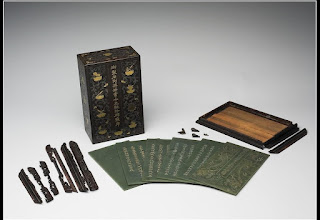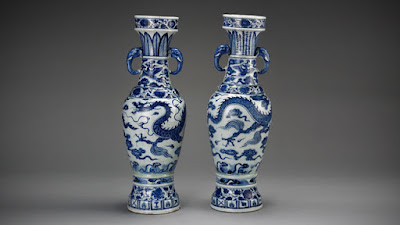 |
Neolithic (10,000-2,000BC)
Chinese Jade Cong, Liangzhu Culture |
Rare Chinese Jades, Neolithic to Han to Song to Qing Dynasty, A Brief History
When many people think of Chinese art the allure and mystique of Jade often springs to mind first. Just hearing the word Jade conjures images of Asia and more specifically China.
Going back thousands of years this harder than steel stone has been mined, carved, shaped and polished in virtually every shape imaginable. From weapons and axes to mythical animal forms, musical chimes, incense burners, suits of armor, hat nobs, hairpins, bowls, boxes, pendants, death veils, vases and hundreds more to numerous to list.
Jade historically has been held in such high esteem it was for centuries believed to have mythical and magical property's, consequently evolving into a primary material of choice for religious ceremony's and burials. The use would determine it's form and shape and even color to accompany the deceased into the after world.
 |
| Han Dynasty (206 BC- 220 AD) Feline Carving in Jade |
Carving jade is really a misnomer as its not actually carved they way other stones, Ivory or wood are. Jade is actually ground and rubbed with abrasives, a laborious process which eventually transforms the stone into the desired shape. During the
Neolithic Period (10,000-2,000BC) using Red sand, sandstone, bamboo and wooden implements were about all that were used. Wood and Bamboo was used to hold the abrasive while it would be tirelessly worked on the stone to shape it and smooth it out. Drills made from bamboo working the abrasive could in time create holes, channels and grooves resulting in the manufacture of "Bi" disks and "Cong vases", plaques and mythical beasts. In the earliest periods most of the carving was largely comprised of small amulets, ritual objects and other simple implements.
 |
| Warring States (403BC -221BC) Period Jade Plaque |
Over the centuries into the
Shang Dynasty (1600 -1029BC) with the invention of bronze and then steel, better tools became available for working this incredibly tough rock into the desired forms. Interestingly even when Bronze became available, initially bamboo remained more popular due to it's plentiful supply and bronze's relatively higher cost. More complex forms evolved on an ever increasing scale over time and the objects became larger as better tools became available utilizing metals.
 |
Fine Spinach Green Jade Incense Burner,
Qianlong Period (1736-1795) |
With the invention of a foot powered treadle lathe circular saws with mounted steel and bronze worked well in turning the pieces with more precision than ever before possible, leaving the worker's hands free to manipulative the carving. By the 4
th C. BC Eastern Zhou /Warring States Period the craft had become very sophisticated including undercut examples, loose link chains and reticulated forms.
 |
Han Dynasty (206BC-220AD) Jade Suit,
Gold Threads backed with Red Silk |
During the
Han Dynasty (206 BC- 220 AD) the importance of jade to Chinese culture was no where made more obvious than by the discovery of Jade suites made for the burial of members of the Imperial house during a 20th C. excavation of some tombs. The suits were sewn together using either gold, silver of copper threads/wires and backed with red silk. Since the initial discovery 18 Han tombs have been found containing such amazing creations.
As China's constantly changing political landscape moved through the centuries ever changing regional governments, wars and turmoil created new or changed views towards art which created constant change. Buddhism's influence, evolution in fashion, burial rituals, scholar's objects all melded together over time creating a vast broad expanse of desirable forms were produced to meet demand of the powerful among the heads of Government, religious intellectuals and wealthy merchants. Eventually, these influences would trickle down to greater and lesser degrees among the working classes.
 |
| Imperial Qianlong (1736-1795) Carved Jade Fish |
Throughout it all Jade, the hardest and one of the most beautiful of all stones remained a staple material for inclusion in all kinds of art. Initially Nephrite was the most common type and later Jadeite found it's way onto the carvers table. The two type are both referred to as jade, though they are structurally very different but share similar hardness qualities. Jadeite is slightly harder on the Mohs Scale by around half a point of 6.5 to 7, Nephrite Mohs scale hardness is in the 6 to 6.5 range.
 |
| Imperial Qianlong (1736-1795) Jade Book |
Nephrite ranges in color from the two most well known a deep dark green and a slightly off white often referred to a "Mutton Fat" in between you can find many ranges and tones of yellows, browns, blue, amber, white, a dry white appearing type known as "Chicken Bone", grey, pale Celadon, russet, red and many more. Very often combinations of these colors can be found in single carvings, which further tests the skills who can successfully seek ways to incorporate these colors into the piece.
During the
Ming Dynasty (1368-1644) jade carving returned to more traditional antecedents reflecting the work done during the Han and Song periods. Jade carving during the
Yuan (1271-1368) period, like many traditional Chinese arts, fell to the wayside during China's years under the Mongols. The revival of traditional art including splendidly executed small mythical creatures, calcified jades resembling Neolithic examples and religious ritual pieces came back into favor among the Imperial court as well as scholars and the literati classes.
Slide Show Of Imperial Jades of the Qing Dynasty (1736-1795)
By the
Qianlong (1735-1795) period in China Jade carving had reached a level of elegance and detail never imagined before. China had become an economic powerhouse in world trade, the wealth of this Emperor exceeded the entire wealth of every nation in the west combined.
 |
| Fine Qianlong (1736-1795) Period Celadon Jade Mythical Beast |
The Qianlong Emperor was a true patron of the arts and encouraged almost unbridled creativity among artists. He was also a collector on an epic scale who delighted in seeing new ideas in ceramics, glass, enameling and jade and painting. Thousands of tribute pieces were made for him during his reign filling the Imperial Palace, the Yuan Ming Yuan and pretty much anyplace else he hung his hat. Its been said the Imperial Jade collection under Qianlong exceeded 35,000 examples.
Today the variety of Jades in all of their forms represent the cumulative work of thousands of years. Enjoy them.
Please feel free to contact me with any questions regarding your Asian art. After 35 years its what we do every day. 978 283 3524
~ Peter L. Combs, Gloucester, Massachusetts









Comments
Post a Comment
If you have any questions or comments please send us a message. Or use the Contact Us tab at the top of the page.